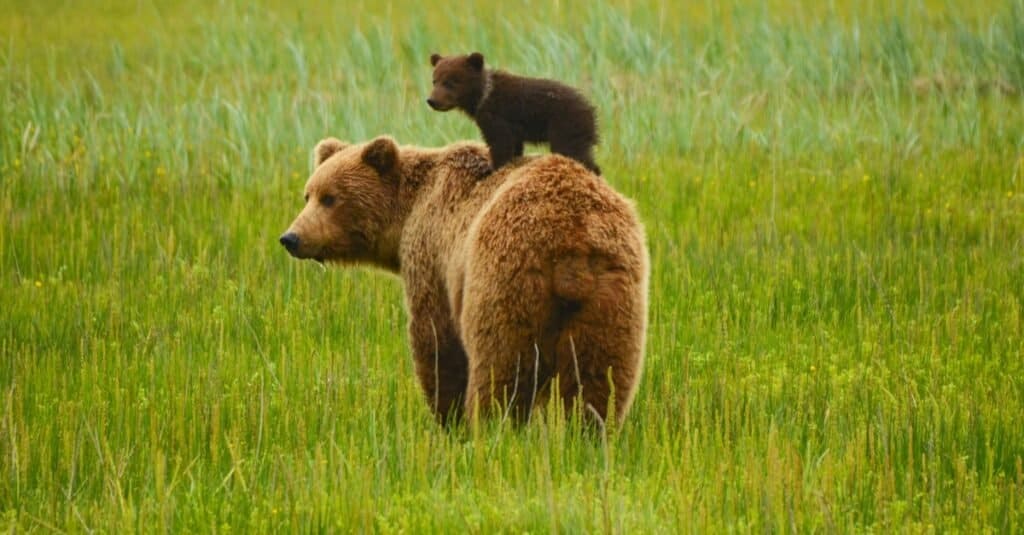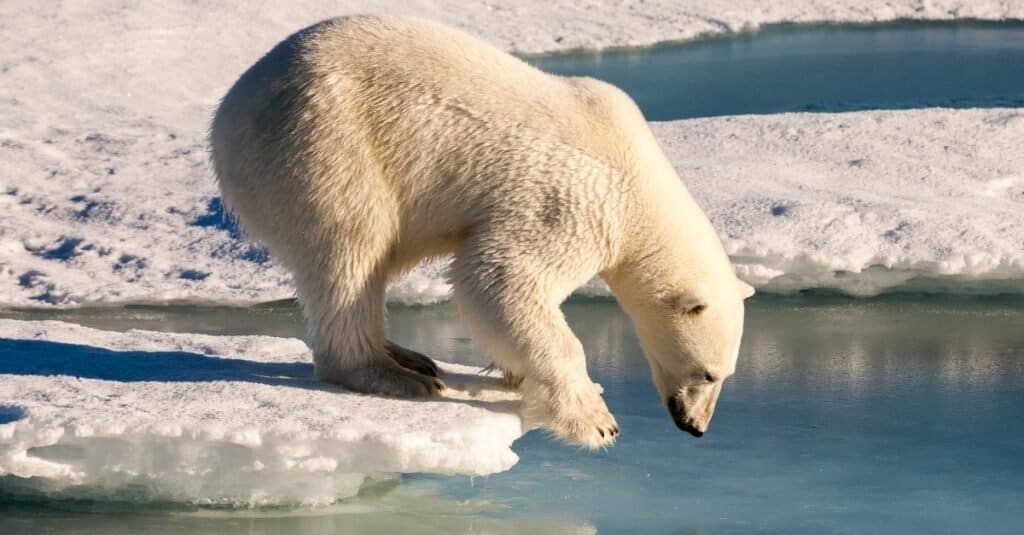What’s your favorite type of bear? Do you admire the strength and tremendous size of grizzly bears? Or maybe you enjoy watching the playful activities of panda bears. Perhaps you love all types of bears! If you’ve ever visited bears at a zoo or wildlife park, you probably took note of the color of the bear’s fur, its claws, and maybe even its sharp teeth. These are all notable things about bears. But, with all you know about these incredible mammals, have you ever wondered: Do bears have tails?
Read on to discover the answer to that question. Also, take a closer look at specific types of bears such as grizzly bears and Koala bears along with others. Find out what they do with their tail if they have one.
Do Bears Have Tails?
Yes, bears have tails. Some bears have a tail you can see just by observing the animal as it walks around. Other types of bears have a tail, but it can’t be seen unless you’re looking at an X-ray of the animal’s skeleton. The tail of a bear is known as a vestigial tail.

©David Rasmus/Shutterstock.com
What is a Vestigial Tail?
A vestigial tail is essentially a small portion, or vestige, of what used to be the full-sized tail of a bear or other type of animal.
Over millions of years of time, a bear’s tail became less necessary for its survival. Consequently, each new generation of bears had tails that were smaller and smaller in size. Today, most bears have short, stubby tails that don’t serve a specific purpose. Biologists can only guess what the original tail of a bear looked like.
Why Do Some Animals Have Tails?
Looking at a mammal with a tail is helpful in seeing why bears only have a vestigial tail.
A kangaroo is a mammal notable for its long, powerful tail. A kangaroo uses its tail every day to maintain its balance. If a kangaroo is slowly hopping through a grassy field to eat, it uses its tail as balance when it’s moving slowly or standing still. Alternatively, this mammal uses its tail as it travels at speeds of 30 mph or faster. Its tail serves as a spring to propel this animal up and forward. So, because a kangaroo needs its tail to move around to find food and escape from predators, it has a full tail as opposed to a vestigial one.
Do Grizzly Bears Have Tails?
Yes, grizzly bears have a vestigial tail measuring from two and a half to eight inches long. A grizzly bear’s tail is difficult to see because it disappears into the thick, brown fur of this bear.
Grizzly bears can weigh as much as 800 pounds and stand eight feet tall. They live in North America, specifically the Pacific Northwest. These bears are omnivores eating leaves, berries, and roots as well as very large mammals including moose.
Grizzly bears can run as fast as 35mph. They use their three to four-inch-long claws to grasp the earth as they move. They also use their claws to climb trees. This bear’s front legs are shorter than its hind legs. This means they can carry a lot of their body weight on their hind legs. This weight shift also helps the animal to balance itself while running.
Grizzly bears don’t need a tail to maintain balance while running or while climbing a tree.
Do Polar Bears Have Tails?
Yes, polar bears have a vestigial tail. Similar to grizzly bears, a polar bear’s five-inch-long tail is hard to see because it virtually disappears into the thick, white fur of this mammal.
You probably already know that polar bears live in the snowy, icy Arctic region where the temperatures drop well below freezing. This is why these bears have two thick layers of fur along with extra body fat. These warm-blooded animals need to keep warm!
A polar bear has webbing between its claws so it can swim in the Arctic waters. Also, the pads of a polar bear’s feet have tiny bumps on them that serve as traction as they walk on the slippery surfaces in their habitat. So, they don’t need a tail to help them keep their balance as they move through their environment.
One unique thing about a polar bear’s vestigial tail is it’s covered in an extra layer of blubber. Even though the bear doesn’t use its tail, this extra layer of blubber prevents its tail from freezing. Its tail also contains a blood vessel so blood can circulate through it in a normal way.
Would a Full Tail Be a Disadvantage for a Polar Bear?
Yes. A full, long tail on a polar bear would release heat from the bear’s body. This would be a serious disadvantage or even a danger for an animal living in freezing temperatures.
The same could be said if a polar bear had large ears like an elephant. The small ears of a polar bear release very little heat allowing this mammal to maintain a normal body temperature.

©Mario_Hoppmann/Shutterstock.com
Do Panda Bears Have Tails?
The black and white face of a panda bear is so cute it’s easy to overlook the other end of its body. But panda bears do have tails. A panda bear’s tail is around five inches long.
Do Panda Bears Use Their Tail?
So far, most of the bears on this list don’t have a purpose for their tail. But pandas are a little different. This bear’s tail has a few purposes.
Pandas have scent glands located beneath their tail. Their small tail covers these scent glands to protect them as a panda climbs or walks around its habitat.
A panda releases an odor-filled liquid from these scent glands. The bears do this to mark their territory. A panda uses its tail to brush the stinky liquid onto tree trunks, branches, or other surfaces.
Along with using its scent to mark their territory, male pandas use this scent to attract females during the breeding season.
Do Black Bears Have Tails?
Yes. A black bear’s tail measures from three to five inches long. Its tail gets lost in the dense black coat of this animal. In fact, in relation to this bear’s five to six-foot-long body, its tail is tiny.
These animals are found throughout the United States as well as in Canada. They live in conifer and deciduous forests. So, do black bears use their vestigial tails?
No. These animals are experts at climbing trees with the help of their long, sharp claws. Like grizzly bears, black bears can move quickly as their claws grasp the ground to keep them balanced. So, this bear’s tail doesn’t serve any specific purpose for this mammal.
What is a Koala Bear?
Koalas are native to Australia. Though it has the word bear in its name, a Koala bear is more of a marsupial. But it is still officially called a Koala bear.
Unlike the others on this list, Koalas weigh only around 30 pounds and measure a little over two feet in length.
There’s a common misconception that Koalas don’t have tails. The truth is they do have tails, but with a twist on that fact.
Do Koala Bears Have Tails?
Yes. Though Koalas don’t have a visible tail they do qualify as having one.
If you look at an X-ray of a Koala or a skeleton of this mammal, you’ll see its vestigial tail. It is short like the vestigial tails of most other bears. But a Koala bear’s vestigial tail seems a little larger than other bears mostly because of its smaller body.
So, the vestigial tail of a Koala bear exists, but not on the outside of its body. This means the animal couldn’t use its tail even if it wanted to!
Think about the daily activities of a Koala. It climbs trees, eats eucalyptus, and sleeps. It has no need for a tail. This Australian mammal uses the rough pads on the bottom of its feet as well as its sharp, curved claws to climb the trees in its habitat. It doesn’t need a tail for balance or help in climbing.
Will the Vestigial Tails of Bears Ever Disappear Completely?
Maybe. It took thousands of years of evolution for them to shrink to the vestigial tails they have now – because they just don’t use them. They don’t need long tails to balance or to communicate. They don’t even wag their tails when they get excited! However, the main purpose of bear tails is to cover their rear end and protect them from the cold and potential parasite attacks. Typically, their sensitive body parts are not covered in fur, so the tail acts as covering and does serve a purpose. So for now, if someone asks you: Do bears have tails? You now know the right answer!
Up Next…
- Bear Predators: What Eats Bears?: It’s hard to imagine – but there are animals that prey on bears! Learn all about them by reading this!
- 10 Incredible Grizzly Bears Facts!: Grizzlies are one of the most fascinating bears – sparking fear in the hearts of man. Discover more about these amazing animals!
- Which Animal Has the Longest Tail?: Speaking of tails – many animals use theirs a lot- including this long tailed creature. Find out which animal’s tail is the longest!
- Are Pandas Dangerous?: They look so cuddly and cute – but are they as harmless as they seem? Find out!
The photo featured at the top of this post is © Dgwildlife/Shutterstock.com
Thank you for reading! Have some feedback for us? Contact the AZ Animals editorial team.






